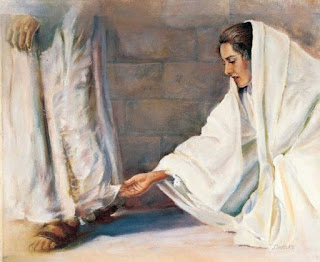The language of the senses can be understood literally, metaphorically, or both together, as in the Gospel accounts of Jesus touching people in need of healing and allowing himself to be touched by the sick.
The literal meaning of touching refers to laying one’s hand on something or some person. The metaphorical meaning refers more to something that influences our feelings or emotions. We can be “touched” in various ways by, for example, images of suffering children in Gaza, by a storyteller bringing tears to our eyes with a tragic tale, by listening to sublime music, by encountering a lovely natural scene, and countless other examples.

Such “touching” moves our heart and can often be a prelude to action, from helping the suffering, to praising God for music and nature. There are also lesser used metaphorical references to “touching” which may not be as meaningful. In the past, a colloquial way of talking about someone with a mental illness was to say that he or she was “touched” and someone begging could be said to be “touching” you for money!
While faith in the Gospels is most often expressed in terms of hearing and seeing Word of God or the deeds of God in a deeper way, we shouldn’t ignore the way in which faith can be understood as touching God in Jesus!
Consider for a moment the story of the woman with the haemorrhage who is healed by Jesus, unknown to him, when she creeps up behind him in the crowd and touches the hem of his garment (Mk 5:25-34). She clearly must have seen him from a distance and heard something of his message. But that was not sufficient to bring healing. They were just first steps.
We can imagine her pushing her way through the crowds, braving the dirty looks and curses, to get closer, before she makes the last dive in his direction as he moves away. Yes, she just about touches him, and it is absolutely electric. Healing power courses through her and dries up that cursed bleeding.
Her seeing, hearing, and touching had a literal, physical meaning, but more importantly a deeper, metaphorical (though no less real for that) meaning of coming to faith in this charismatic person who radiates such healing power. Her heart and soul are touched as much, if not more, than her body. Seeing and hearing is completed by touching, the touch of faith.
This lovely, touching story speaks to me of the remarkable intimacy of the sense of touch. It is more intimate than seeing and hearing. You can see and hear at a distance, as most of the crowds did who followed Jesus, but you must get up close and personal to touch someone as this woman has done.
Not only does Jesus allow people to touch him for healing, but he also takes the initiative in touching those who are in need. In the Sunday’s Gospel (February 4) (Mk 1:29-31), Our Lord goes to the house of Simon and immediately heals the feverish mother-in-law by touching her.
“He went to her, took her by the hand and helped her up” (v.31). No word is spoken and there is little to see, just the power of three – he went, he took, and he helped. And the fever fled, and she waited on them.
There is something embarrassingly intimate in the way Jesus touches people and allows himself to be touched. When he attempts to wash his disciples’ feet, Peter can’t take it. When a woman of doubtful reputation, anoints his feet and weeps tears over him, everyone is scandalised.
How can God lower himself to this degree, even in becoming human! Has he no shame, this God who, in the Old Testament, is untouchable, a flaming bush, a cloud in the Temple that blocks even the priests from entering!
But this is the immanent God, the God who is close enough to be touched. No need for binoculars or hearing aids. He is close and his closeness is so healing, so touching.
And he cannot stop touching! He appeared in the Sunday Gospel last Sunday (February 11) healing a leper, another untouchable (Mk.1:40-5). For the Lord, to touch him will render himself unclean, as well as a danger to others of contamination.
But Mark will proclaim another three-step healing: “Feeling sorry for him, Jesus stretched out his hand, and touched him” (v.41). And we can be sure that the leper was also touched to the core of his being by the love that flowed through that stretched out hand and the comforting words, “Be cured” (v.41).
So faith is indeed a form of touching. But first, we must be touched by the love of Jesus which then awakens our faith, leading us to touch him in turn. The touch of love invites the touch of faith.
Let us not forget that the same Lord who walked the roads of Galilee two thousand years ago is still inviting us to touch him in Holy Communion with our hands and tongues, but also through the faith in our hearts in his real presence.
And he in turn wants to touch us with the healing we need in every aspect of our lives. The disciples, being “touched” by God’s Spirit at Pentecost seemed to the crowds as if they were either drunk or mad. But this experience is essentially the influence of the Divine Madness of Jesus who like a poor person “touching” someone for alms, touches us for our love as the Divine beggar!
Kieran ofm
